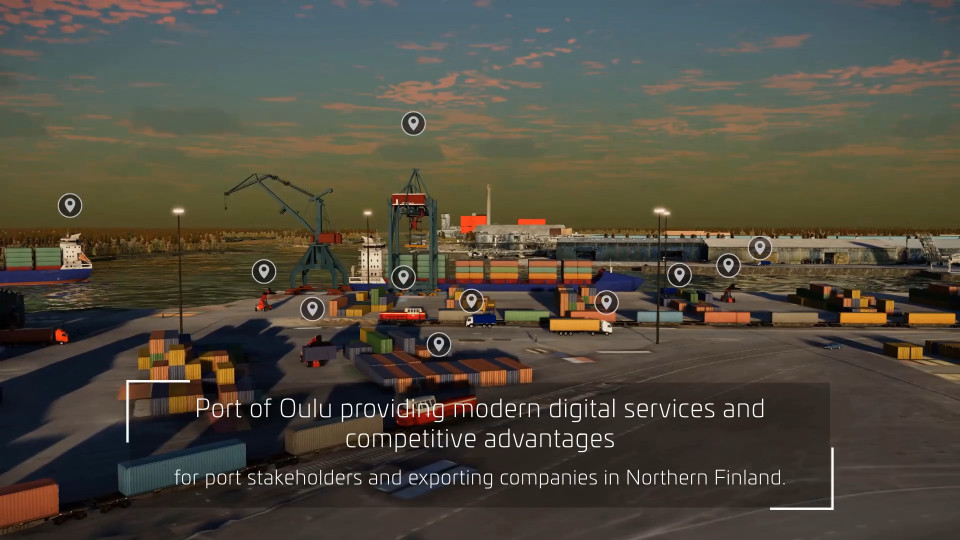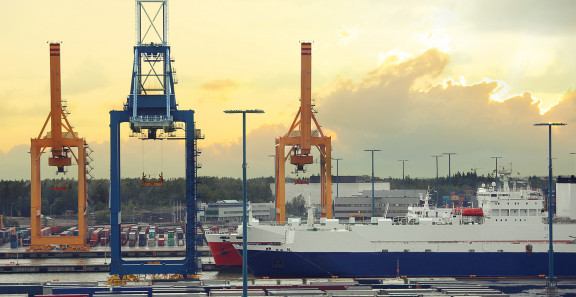The Port of Oulu is one of the largest general harbours in the Bay of Bothnia, and its users have high expectations and quality standards. Finnish import and export companies are required to be increasingly cost-effective, responsive and ecological, and to have greater transparency in their logistics chains. “Our partner network wants the port to take responsibility for driving the development of digital services – and that’s the path we’re now on,” says the port’s Managing Director, Marko Mykkänen.

Sitowise’s digital services have for years included efficient data collection and the visual representation of urban environments. Dynamic and interactive digital twins are another step forward. The Port of Oulu’s digital twin will provide port operators with up-to-date information and an easy-to-understand visual overview of the current situation.
The Port of Oulu’s continually evolving infrastructure is one of its competitive advantages. The port is about to open a new 12.5-metre fairway and dozens of hectares of additional space in the harbour area. Digitalisation is bringing new elements to support its traditional strengths. ”Improving our customers’ competitiveness is our top priority. When companies in Northern Finland are doing well, the port also does well,” says Mykkänen.
Dynamic digital twin attracts interest in the sector
A digital twin is usually defined as a visual representation of a real-life physical entity. Jarkko Männistö, an expert in virtual models at Sitowise, thinks that digital twins should also be dynamic. “The model will then illustrate movement and include genuine challenges in the environment.”
A dynamic and interactive digital twin of the Port of Oulu has been created, and its potential was initially tested in a pilot project. “The pilot showed that we’re able to read information from the data pool, visualise it as a 3-D model, and publish it in almost real time,” says Männistö. “We’ve also developed connections between the real and digital world.”
The model currently runs a variety of simulations that help to design operations in the area, such as smart lighting. Weather service data can also be linked to the model. “It’s important to know how factors such as darkness, wind, rain or ice will delay operations,” says Männistö.
In the future, the digital twin will help to illustrate activities related to the port’s vessels, land transport and infrastructure. “The digital twin will also create opportunities for developing autonomous transport, drone transport, and the use of artificial intelligence in, for example, vehicle identification,” adds Männistö.
“A digital twin is a user interface for information”
For the Port of Oulu, the digital twin’s most important task is to collate the activities of different operators in one place. The goal is to share up-to-date information about the port’s operations throughout the ecosystem, for example, with piloting and security services, authorities and companies all along the logistics chain. “Visiting traffic arrives at the port by road, sea and rail,” says Mira Juola, who heads up digitalisation at the port.
She says that the digital twin illustrates port operations and provides everyone operating in the area with visual information about the current situation. “This modern, agile and dynamic data platform illustrates how the port is operating, providing services, and evolving. The digital twin is one of our most important user interfaces for information.”
Network capacity, such as 5G connections, is also considered during the digital twin’s development. While national network operators are modelling entire cities to evaluate signal paths, the port acts as a local micro-operator. “We must remember that the port is constantly changing. For example, ships or stacks of containers can block signals.”
The port therefore wants to ensure that digital services are available under all circumstances. “We also want to use the digital twin to visualise network capacity and signal strength,” says Juola. “This will enable us to provide port operators with up-to-date information about the network’s status and quickly resolve any connectivity issues.”
Information sharing is the circular economy of the digital world
Sitowise’s Männistö sees digital twins as an opportunity to enrich data models so that data is utilised in an open and versatile manner. “A digital solution’s most important task is to assist in the harnessing and sharing of data. It’s the circular economy of the digital world.”
From the perspective of data management, the world is getting increasingly chaotic and Männistö thinks that huge volumes of data are posing a challenge for ordinary people as well as experts in the field. “Data comprehensibility has become a core issue – and that’s the strength of a digital twin.”
Digitalisation is well underway at the Port of Oulu, and Mykkänen says that development work is being undertaken as a cohesive process rather than as individual projects. Both he and Juola are very pleased with their collaboration with Sitowise. “Sitowise’s specialists have both expertise and enthusiasm for developing our digital twin. A desire to learn together is also important when building new things!”
